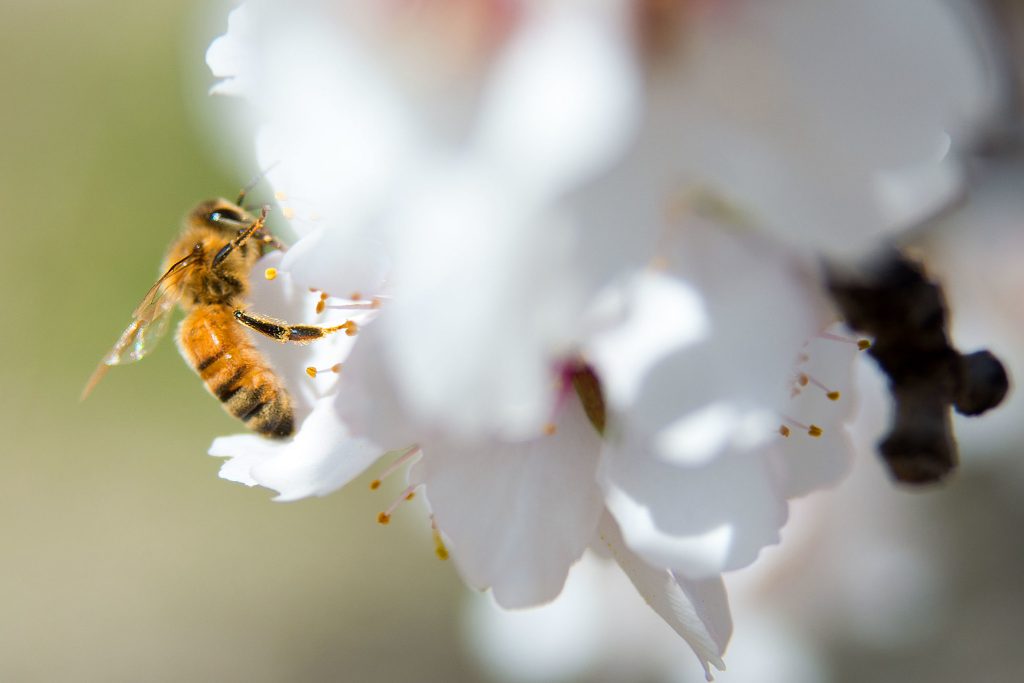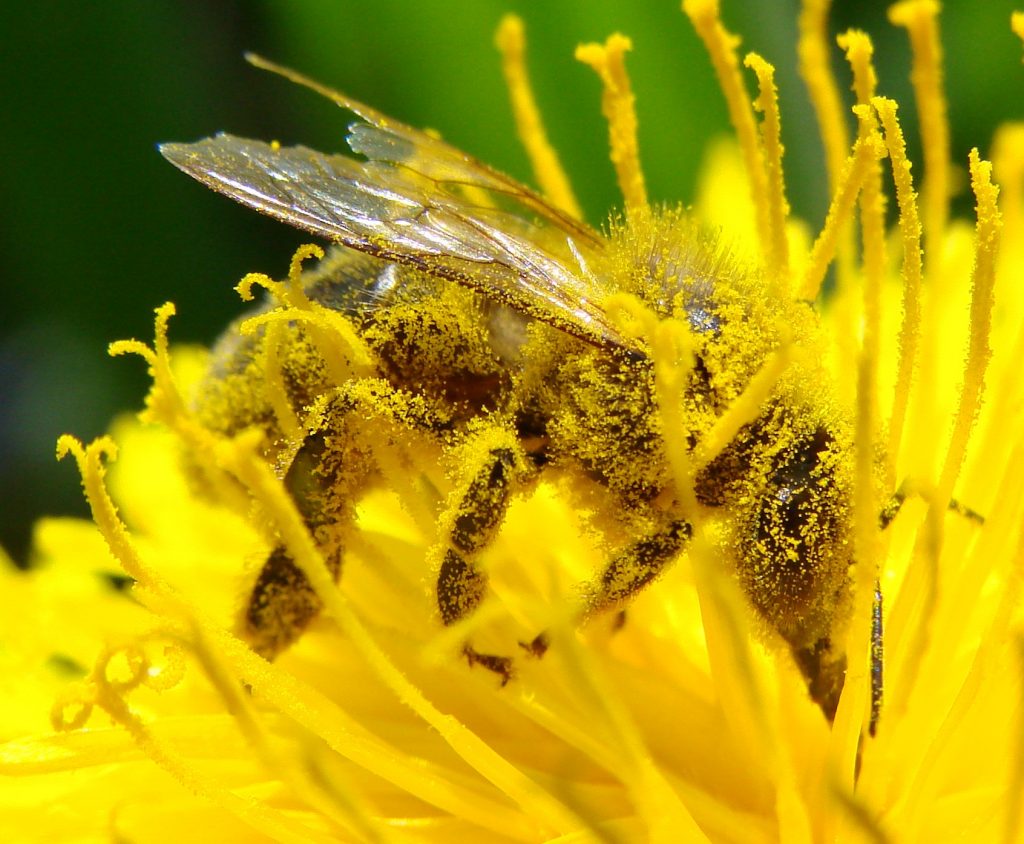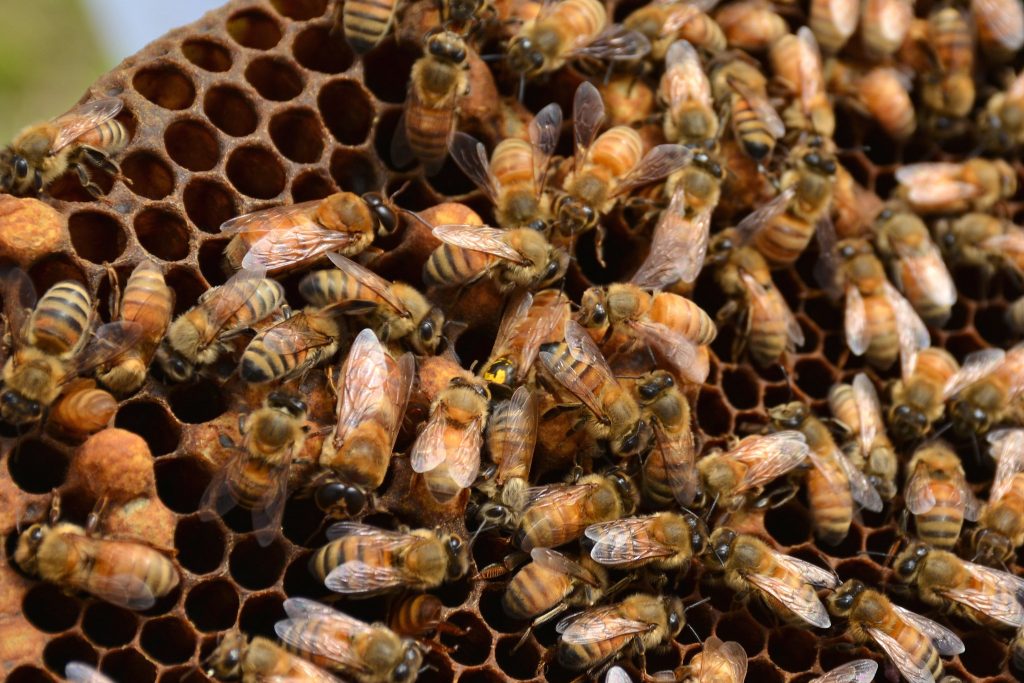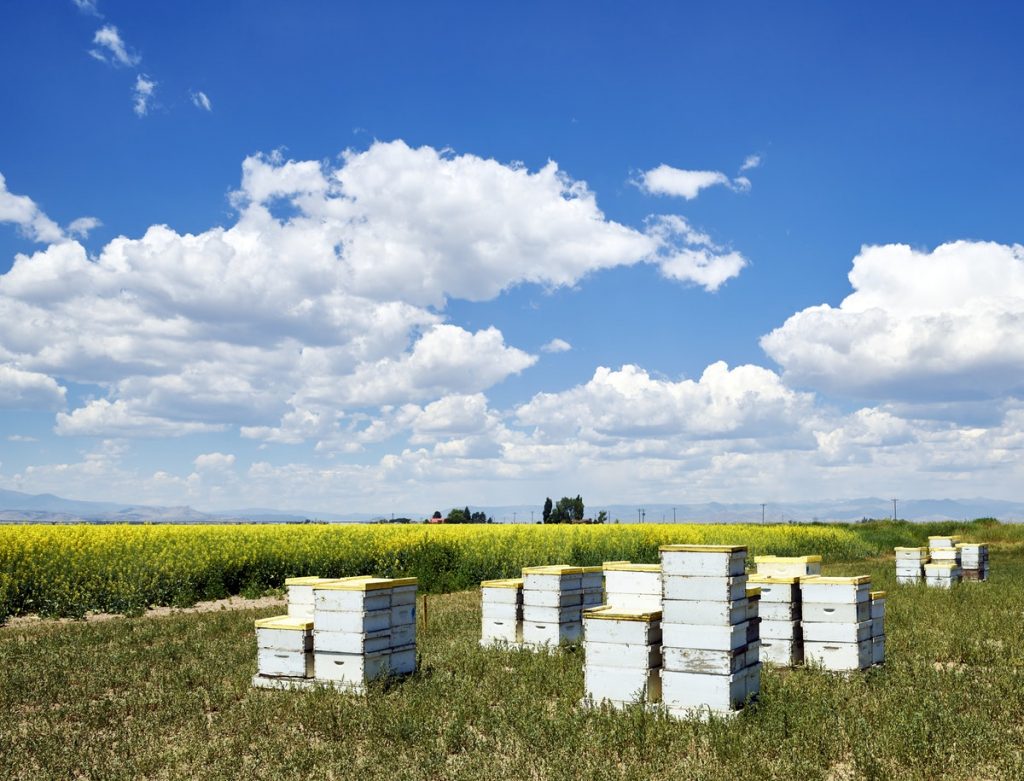Bees are part of the food cycle in one of the most essential ways—they help pollinate our food. Why is this important? In order for plants to produce the fruits, nuts, and vegetables that we eat, bees (more specifically, worker bees) collect nectar and pollen from flowers. When they fly to another flower, they unintentionally rub that pollen onto the new flower, pollinating it [i]. There is more to the science, but basically, by doing this, the bee has fertilized the flower, making it possible for the plant to produce food.

The lifeline of the bee
Worker bees, which are all female, live six weeks in the summer and a few months in winter. There is a significant die-off of the population in winter, and in spring and summer they produce new worker bees. During a typical winter a colony of bees will reduce in population by 5–10%. In some bad years, as much as 15–20% of the colony will die off [ii]. With the growth of the human population and other causes of decline, which we’ll get into below, winter die-off has increased to 30–90% over approximately the past 75 years in some locations in the United States.

Why are they disappearing?
So, why are the bees disappearing at unprecedented rates? There are many reasons why, and each bee species has different causes for their decline. Unfortunately, their population reduction mostly has to do with humans. “Pesticides, fertilizers, parasites, biodiversity loss, deforestation, changes in land use, and habitat destruction are just a few of the reasons bee populations have dwindled,” said Sophie Hirsh [iii]. Here are some details about each of these issues:
- Pesticides, fertilizers, and parasites are used in the hope to increase the production of food or to kill undesired pests; however, they also kill and hurt bees.
- Biodiversity loss of bee species increases the rarity of specific types of bees, which lowers the yields of pollinator-dependent crops.
- Deforestation, changes in land use, and habitat destruction reduces the diversity of nesting areas for the bees, who flourish better in diversified habitats. [vii]
Scientists are working to monitor these bees and collect data, which they are hoping will help us begin to conserve them.
Help count the bees
The US National Native Bee Monitoring Network relies on community scientists to help collect data on bees. This effort is managed by thirteen native-bee biologists from across the United States. People of all ages can help count and photograph bees, and then submit the data they collect. A group of experts will then analyze and confirm these observations, which help scientists study the plight of native bees and consider possible solutions. [iv] [v].

Saving the bees
We need to change our agricultural systems, which are one of the main causes of native bee declines. Luckily, there is a list of things that farmers, land managers, and community members can do to help restore bee populations: begin using more ecological agricultural methods, stop using certain types of pesticides, and preserve wildland habitats [ii].
Agricultural methods
The idea of using more ecological agricultural methods isn’t new, as many current organic/ecological farmers are already using ancient, more natural farming methods that have been around for centuries [ii]. Using these natural, ecological, and organic farming techniques we can help preserve ecosystem diversity, restore soil nutrients, lessen soil loss, and avoid pesticides and fertilizers.
A large issue in agriculture is the widespread use of pesticides that affect bees, including three types of nicotinoid, chlorpyriphos, cypermethrin, deltamethrin, and fipronil [ii]. These can accumulate within bee colonies where the bees begin to experience development defects, weakness, and loss of orientation, creating weaker bees. What is more important than learning the effects of pesticides is the work to stop using them.
What you can do at home
It may take years to make major changes to large-scale agricultural practices [vi] but making the decision not to use these pesticides in our yards and gardens at home is a great start. There are plenty of natural methods and products that you can use to help lower the risks of plant disease and pests, including Avenger, Safer Soap, Neem Oil, and various Down to Earth products. For more information on different Organic pest management and fertilizers visit this Beyond Pesticides website.

Another piece of the puzzle that starts at home is preserving native bees’ habitats. If you have a lawn you don’t use that much, consider removing it and planting native grasses and perennials. It will benefit both you and the bees to have additional flowers in your yard. We can also work together to preserve native habitats so that they aren’t lost to land development needs.
Together, we can stop bee endangerment.
Works cited
[i] The Importance of Bees: Pollination. (n.d.) Canada Agriculture and Food Museum.
[ii] Save the Bees: Be the solution to help protect bees in crisis. (n.d.) Greenpeace.
[iii] Hirsh, S. (29 July 2020). Bee Population Decline Puts These U.S. Crops at Risk, Study Finds. Greenmatters.
[iv] Hollow, M. (7 Dec 2020). How You Can Help Count and Conserve Native Bees. The New York Times.
[v] US National Native Bee Monitoring Network. (n.d.).
[vi] Kuenzle, M. (24 April 2013). Bees in Decline: How long will pesticide companies deny science?. Greenpeace.
[vii] Zattara, E. & Aizen, M. (22 Jan 2021). Worldwide Occurrence Records Suggest a Global Decline in Bee Species Richness. Science Direct. 4,1.
Help protect and restore the Morro Bay estuary
- Donate to the Estuary Program and support our work in the field, the lab, and beyond.
The Estuary Program is a 501(c)3 nonprofit. We depend on funding from grants and generous donors to continue our work. - Support us by purchasing estuary-themed gear from ESTERO. This locally owned and operated company donates 20% of proceeds from its Estuary clothing line and 100% of Estuary decal proceeds to the Estuary Program. Thank you, ESTERO!
- Purchase items from the the Estuary Program’s store on Zazzle. Zazzle prints and ships your items, and the Estuary Program receives 10% of the proceeds. Choose from mugs, hats, t-shirts, and even fanny packs (they’re back!) with our fun Estuary Octopus design or our Mutts for the Bay logo.